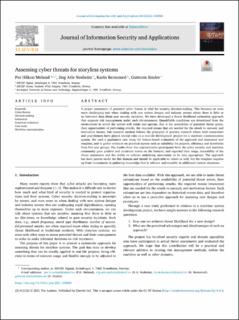| dc.contributor.author | Meland, Per Håkon | |
| dc.contributor.author | Nesheim, Dag Atle | |
| dc.contributor.author | Bernsmed, Karin | |
| dc.contributor.author | Sindre, Guttorm | |
| dc.date.accessioned | 2022-08-17T14:25:48Z | |
| dc.date.available | 2022-08-17T14:25:48Z | |
| dc.date.created | 2021-11-09T13:37:35Z | |
| dc.date.issued | 2021 | |
| dc.identifier.citation | Journal of Information Security and Applications. 2022, 64, 103050. | en_US |
| dc.identifier.issn | 2214-2134 | |
| dc.identifier.uri | https://hdl.handle.net/11250/3012379 | |
| dc.description.abstract | A proper assessment of potential cyber threats is vital for security decision-making. This becomes an even more challenging task when dealing with new system designs and industry sectors where there is little or no historical data about past security incidents. We have developed a threat likelihood estimation approach that supports risk management under such circumstances. Quantifiable conditions are determined from the environment in which the system will reside and operate, that is the availability of potential threat actors, their opportunities of performing attacks, the required means that are needed for the attack to succeed, and motivation factors. Our research method follows the principles of practice research where both researchers and practitioners have played central roles in a real-life development project for a maritime communication system. We used a qualitative case study for feature-based evaluation of the approach and associated tool template, and to gather evidence on practical aspects such as suitability for purpose, efficiency and drawbacks from five user groups. The results show that representative participants from the cyber security and maritime community gave positive and consistent scores on the features, and regarded time usage, traceability of the threat assessment and the ability to indicate underlying uncertainty to be very appropriate. The approach has been proven useful for this domain and should be applicable to others as well, but the template requires up-front investments in gathering knowledge that is relevant and reusable in additional context situations. | en_US |
| dc.language.iso | eng | en_US |
| dc.publisher | Elsevier | en_US |
| dc.rights | Navngivelse 4.0 Internasjonal | * |
| dc.rights.uri | http://creativecommons.org/licenses/by/4.0/deed.no | * |
| dc.subject | Cyber threats | en_US |
| dc.subject | Decision-making | en_US |
| dc.subject | Estimation | en_US |
| dc.subject | Empirical evaluation | en_US |
| dc.subject | Case study | en_US |
| dc.subject | Maritime communication | en_US |
| dc.title | Assessing cyber threats for storyless systems | en_US |
| dc.type | Peer reviewed | en_US |
| dc.type | Journal article | en_US |
| dc.description.version | publishedVersion | en_US |
| dc.rights.holder | © 2021 The Authors | en_US |
| dc.source.volume | 64 | en_US |
| dc.source.journal | Journal of Information Security and Applications | en_US |
| dc.identifier.doi | 10.1016/j.jisa.2021.103050 | |
| dc.identifier.cristin | 1952792 | |
| dc.source.articlenumber | 103050 | en_US |
| cristin.ispublished | true | |
| cristin.fulltext | original | |
| cristin.qualitycode | 1 | |

